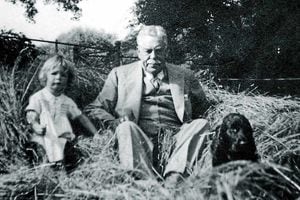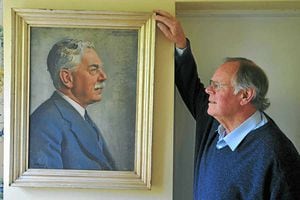Mallard design genius Sir Nigel Gresley is honoured
Sir Nigel Gresley has gone down in railway history as the design genius behind a world-beating icon of British of speed – the sleek, beautiful, and blindingly fast Mallard locomotive.

And now his engineering prowess has been recognised with a top accolade at a special ceremony attended by his Claverley grandson Tim Godfrey.
The Engineering Heritage Award from the Institution of Mechanical Engineers came on the anniversary of the death of the locomotive's designer and in the 75th anniversary year of Mallard setting a still unbroken speed record for a steam locomotive of 126mph.
Today, Mr Godfrey, of Lower Hopstone, said he was thrilled that Mallard was joining the likes of the Jaguar E-Type, Tower Bridge and the Vulcan Bomber after being bestowed with the honour at the National Railway Museum in York, where Mallard is displayed. And he said the engine represented British ingenuity at its best.
"It means an extraordinary amount," said Mr Godfrey, who also celebrated his 75th birthday this year. "I'm very honoured to be related to such an eminent person."
Mr Godfrey was three years old when Sir Nigel died in April, 1941 but he said he had memories of living with him at Salisbury Hall in Hertfordshire.
He remembers him keeping waterfowl on the estate – a love which Mr Godfrey has inherited – and it was this hobby which gave rise to names such as Mallard and Bittern which adorned many of the engines he designed.
Mr Godfrey said that during Sir Nigel's last few months his doctor warned him about his workload, and his need to take things easy. "
His doctor told him if he didn't slow down, he would die within a few months," he said. But to the speed king of the 20th Century, the man who invented high-speed rail almost a century before the phrase had even been coined, the idea of slowing down was unthinkable.
"He was advised to cut his workload down to four days a week, but with the war on, and so many people contributing towards the war effort, that he was unable to do so. Sadly, his doctor proved to be right, and he died in April, 1941," Mr Godfrey said
He remembers his father as being a single-minded, focused individual, filled with energy and a sense of purpose, who was always active even when he was not at work. Mallard was by no means Gresley's first record-breaking locomotive.
His A1 Pacific locomotive Flying Scotsman became the first the railway engine to reach 100mph as far back as 1923.
The driver of Mallard on its record-breaking mission in 1938, Joe Duddington, reckoned it could have managed 130mph had it not been for the signals ahead. Certainly the spectacle of this sleek curvaceous engine must have been a sight to behold.








